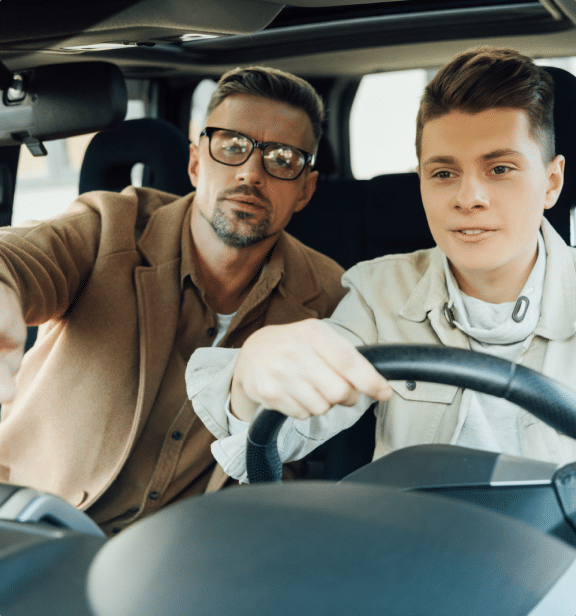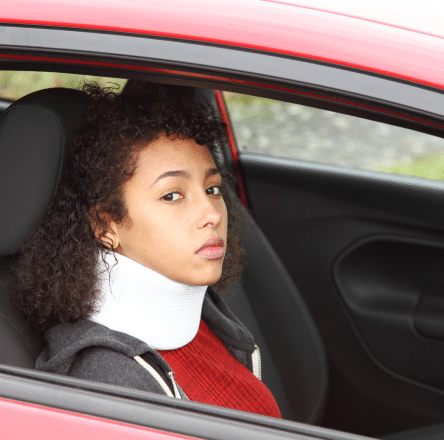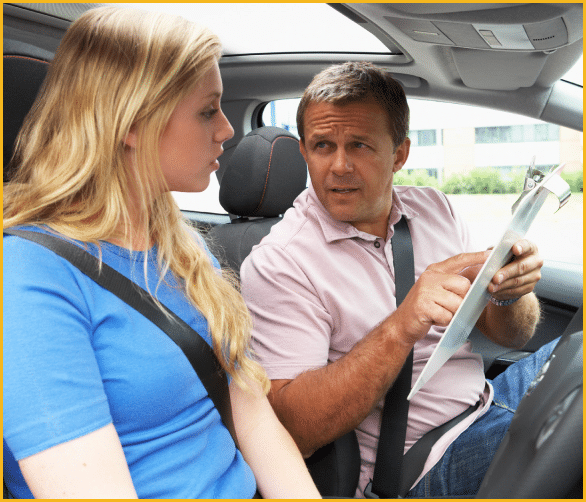Teenage Driving Risks
Handing your teen the car keys might eliminate late-night carpool runs, but you may be up late worrying until they get home. Vehicle crash statistics show that teenagers are involved in more accidents with injuries and fatalities than any other age group. Discussing teenage driving risks with your teen improves teenage driving safety.

Every teenager’s dream is the freedom that comes with a driver’s license and the keys to the family car. While you may welcome the reprieve from carpools and late-night drives to pick up your teenager from their social events, the minute they pull out of the driveway, the nightmares begin.
The statistics are staggering. Teenagers are involved in more car accidents than any other age group, including crashes with injuries and fatalities. Teenage driving risks—from texting while driving and speeding to failing to wear a seat belt—make nightmares a reality for far too many families.
Fortunately, parents can impact teenage driving safety by learning about the driving risks, discussing them with their teens, and taking precautions, including researching safe vehicles and teen safe-driving tech. If your worst fear is realized and your teen is involved in an accident, contact a car accident lawyer for help.
What Factors Put Teens at Risk When Driving?
Inexperience and Immaturity
Per mile driven, 16-year-olds crash 1.5 times more than older teen drivers, according to the Centers for Disease Control. Just like with any new skill, driving has a learning curve. Safe responses do not become instinctual until your new driver experiences and observes more driving scenarios, including dangerous situations and near-misses.
Inexperience coupled with immaturity puts teens at greater risk when driving. As they mature, they make more responsible choices, such as wearing seat belts and ignoring phones while driving.
Loud Passengers
Even with experience and maturity, teens face other driving risks, including the influence of passengers. According to the Centers for Disease Control, your teen’s risk of getting into an accident increases when other teens are in the car. The more teenagers in the car, the greater the risk.
One way to reduce this danger is to include an adult passenger. According to the National Institute of Child Health and Human Development, teenagers are 75 percent less likely to get into a car accident if they have an adult passenger.
Distractions
Passengers are not the only distractions that contribute to teenage driving risks. Distractions outside the car, including other drivers, pedestrians, bicyclists, animals, surroundings, and billboards, impact teenage drivers more than experienced drivers. So do distractions inside the car, such as choosing music, adjusting cooling or heating, referencing guidance systems for directions, and mobile device notifications.
Social Pressure
Unfortunately, passengers create more risk for teenage driving safety than simply distracting the driver. According to a study published in Frontiers in Psychology, teenage passengers are frequently successful in influencing teenage drivers to make unsafe choices, such as running red lights, speeding, and avoiding seat belt use.
How Often Do Teens Get Into Car Accidents?
Teenage drivers are involved in a disproportionate number of car accidents as compared to older drivers, according to the New England Journal of Medicine. Despite making up only 6.4 percent of all drivers, drivers between 15 and 20 years of age are involved in 10 percent of all fatal car accidents and 14 percent of all car accidents involving injuries. According to the Insurance Institute for Highway Safety, in 2021, 3,058 teens died in car accidents. Car accidents were one of the leading causes of death for teen males and the leading cause of death for teen females in 2020.

What Are the Top Driving Risks for Teens?
Speeding
Teens sometimes consciously speed because they are hurrying to work, school, or a social event. Other times, they speed due to drowsy driving, inexperience, or social pressure. No matter the reason, driving at excessive speeds too often results in dangerous accidents. Overall, 25 percent of fatal teen car crashes involve speeding.
Driving Under the Influence
Despite community and educational efforts to inform teens about the dangers of driving under the influence, social pressure and other factors continually contribute to drunk driving. A 2019 survey revealed that 5.4 percent of U.S. high school students had driven after drinking. In 2021, 19 percent of 16- and 17-year-old drivers killed in car crashes had been drinking before driving.
Drowsy Driving
Balancing academic, work, social, and extracurricular demands while enduring physical changes makes it hard for teens to get the 8 to 10 hours of sleep they need. According to the National Sleep Foundation, 55 percent of vehicle crashes attributed in part to driving while drowsy involved male drivers under 26. With almost 75 percent of teens unable to get the recommended amount of sleep on school nights, drowsy driving is a risk for most teen drivers.
Texting While Driving
According to the New England Journal of Medicine, drivers are four times more likely to crash if texting while driving. Today’s teens expect instantaneous responses to communications. Leaving a message unanswered, let alone unread, feels like torture. In a 2019 study, 39 percent of U.S. high school students admitted to texting while driving.
Not Wearing a Seat Belt
Despite the mountain of evidence that seat belts can reduce vehicle accident fatalities by more than half, teens resist wearing them. According to a 2019 study, 43.1 percent of U.S. high school students do not always wear seat belts. Teens who did not wear them comprised 56 percent of teen fatalities from car accidents in 2020.
What Are the Worst Times for Teens To Be On the Road?
When teens have more free time to drive, such as at night, on the weekends, and over the summer, they are more likely to be distracted by passengers and text messages and more likely to drink and drive.
Nighttime Driving
In addition to the potential for increased drowsiness and lack of experience driving in the dark, teens behind the wheel at night are more likely to be accompanied by potentially distracting passengers. The nighttime driving fatal car accident rate for teen drivers is nearly three times that of older drivers. Of all fatal teen car accidents in 2021, 50 percent occurred between 6 pm and 3 am, only nine hours out of a 24-hour day.
Weekend Driving
Teens driving on the weekend may be more likely to be distracted by fun weekend plans or because they could be driving to a less familiar location. They also may be more likely to have distracting passengers in the vehicle if they are with friends. Drinking is also more likely to be involved in weekend activities. Of all fatal teen car accidents in 2021, 50 percent happened over the three days of the weekend.
Summertime Driving
Without the structure of the typical school week, summertime is ripe for dangerous teen driving. Similar to weekend driving, teens may drive with more distracting passengers to less familiar places. Drinking is also more likely to be included in summer plans than during the school year. Of all fatal teen car accidents in 2021, 38 percent occurred over just four months – the summer months of May through August.
How Can Parents Educate Teens on Safe Driving?
Talk to Your Teen
Talking to your kids about teenage driving safety is a proven way to reduce risky teen driving. Discuss safe driving and sign a Parent-Teen Driving Agreement. Include a zero-tolerance policy not only for driving under the influence but also for getting into a car with anyone who has been drinking. A 2019 study revealed that 16.7 percent of U.S. high school students rode with a driver who had been drinking.
In addition to the consequences outlined in your agreement, remind your teen about the harsh consequences of breaking driving laws, including costly attorney and court fees, revoked driver’s licenses, and permanent record of DUIs.
Getting Your Teen Familiar With Their Car
Take your teenager on a tour of the car. Go over functions they will use daily, such as the turn signal, and others they will use less frequently, such as windshield wipers. Your teen will be less likely to be distracted if they’re not searching for the defrost button while driving with the windows quickly fogging up. Review locations of important documents and what to do in case of an accident.
Be a Good Role Model for Driving
When it comes to driving, setting a good example can be the difference between life and death. Model safe driving habits by following the rules of the road and wearing your seatbelt. Never text while driving or drive while drowsy or under the influence.
Track Teen Driving With Apps
Consider using apps to enforce safe driving.
- LifeSaver is an app that will disable distracting phone apps.
- Life360 provides crash detection, roadside assistance, and driving reports.
- SAFE 2 SAVE provides rewards for driving undistracted.
- True Motion Family and Safest Driver provide driving reports.
Enforce Zero Tolerance for Drinking and Driving
Before your teen gets behind the wheel, talk with them about your family’s zero-tolerance plan for drinking and driving. Discuss potential scenarios that could put them in difficult decisions about drinking and driving or riding in a car with someone who has been drinking. Provide alternative ways to handle various scenarios and discuss your expectations. Clarify legal and family consequences for drinking and driving and for entering a car driven by an intoxicated driver. Enforcing zero tolerance for drinking and driving saves lives.
Remind Your Teen of the Consequences of Breaking Driving Laws
Take time to discuss driving laws with your teen. Remind them that learning driving laws goes beyond passing the driver’s test. Review the harsh legal consequences for breaking driving laws, including the potential for:
- Loss of driver’s license
- Permanent record of DUI
- Attorney and court fees
- Impact on insurance rates
Discuss family consequences for breaking driving laws. For example, decide if teens are responsible for covering costs, including parking tickets, court fees, and insurance rate changes.
Choose a Safe Vehicle
According to the Insurance Institute of Highway Safety, vehicles with combined crash avoidance and teen-driver safety technologies could potentially prevent 78 percent of fatalities, 47 percent of injuries, and 41 percent of crashes involving teen drivers. Check the National Safety Council for recalls and research Consumer Reports recommendations for economical, safe vehicles for teenage drivers. Look for cars with updated restraint systems, automatic emergency braking, crash avoidance, and solid curb weight. Add features that help prevent speeding, extend seat belt reminders, and notify drivers of curfew violations.

